
Tips, tricks and menu hacks for growing a foodservice business in a challenging environment.
As the foodservice industry faces rising food costs, labor pressures and flat customer counts, operators are looking to their menus for solutions. Operators can increase profitability if they streamline menus, employ versatile ingredients and update dishes to appeal to consumers eager to try new menu items.
Here are three menu hacks that can help foodservice businesses grow:
1. Increase traffic with new versions of legacy favorites
According to The NPD Group’s Eating Patterns In America report, the aging population is contributing to the decline in total eating occasions on a per-capita basis in the U.S. The report notes that consumers averaged 1,410 eating occasions per capita in 2018, compared to 1,453 occasions in 2009.
While baby boomers are eating out less as they age, millennials are becoming more enthusiastic diners. Consequently, operators are developing menu items that appeal to younger consumers while they strive to cater to longtime customers. That’s been the challenge for Daphne’s, which began more than 25 years ago as a Greek-focused eatery, and has expanded its menu to include other Mediterranean foods.
“Some of our existing customers, who tend to be baby boomers, don’t like a lot of change, and they perceive Daphne’s value as being a really good product at an inexpensive cost,” says Dave Eldredge, director of marketing for Elite Restaurant Group, parent company to Daphne’s. “Whereas new customers, millennials, are looking at the experience ... and they want an authentic Mediterranean experience.”


Among the menu updates, Daphne’s replaced its rice pilaf with seasoned basmati rice. “Our millennial customers love it,” Eldredge says. “But we get complaints from existing customers, saying ‘You haven’t changed the rice in 20 years. Why are you changing it now?’”
Daphne’s still offers familiar foods at a value price, such as Classic Pita, Falafel Pita or Spicy Chicken Pita, and popular sides such as fries. The fries are available with the combo meals, and to satisfy consumers looking for a bold flavor profile, there are also Fire Feta Fries, which are topped with cheese sauce.
Using versatile ingredients such as fries in several dishes makes it easier for kitchen staff to prepare a variety of menu items.
2. Simplify operations for back-of-the-house
Menu planning begins with input from the chain’s culinary experts as well as operations and marketing teams. New menu items must be simple for franchisees of Daphne’s to execute. “We can’t succeed unless our franchisees succeed,” Eldredge says. “We make sure our items are healthy, prepared consistently and are profitable for franchisees.”
One way to make food prep simple is to streamline the menu. At Penn Station East Coast Subs, the core menu consists of Grilled Subs and Cold Subs, and certain ingredients are used for several menu items. For example, the sauce on the Pizza Sub also is used to flavor the Chicken Parmesan Sub. Also, there is one type of ham for the Ham & Swiss Sub and the Chicken Cordon Bleu Sub.


We have a lot of interchangeability of ingredients,
says Craig Dunaway, president of the Cincinnati, Ohio-based chain. “We have chicken tenders that go on about seven sandwiches. You’re reaching into one pan for every chicken sandwich.”
Having a versatile palette of ingredients and straightforward sandwich-making instructions can help simplify operations. That’s important in the current labor environment. “It’s critical when unemployment is 3.7 percent not to tax the operator, manager or kitchen with complex items that wind up being only 1 or 2 percent of sales,” Dunaway says.
3. Keeping food costs low
Rising food costs are a factor in planning any menu. According to the U.S. Department of Agriculture Economic Research Service, in July 2019 the food-away-from-home consumer price index (CPI) increased 0.2 percent compared to June 2019, and was 3.2 percent higher than July 2018.
One way for operators to manage food prices is to limit food waste. Penn Station East Coast Subs not only uses the same ingredients for many sandwiches, but it also limits the side order and dessert choices.
The Fresh Cut Fries are very popular, so there is no reason to add a more expensive, less profitable side order.
Also there is only one dessert, a Chocolate Chunk Cookie. “If you have 10 cookies or two, I can guarantee 90 percent of the orders will be chocolate chip,” Dunaway says.
While the menu is short at Penn Stations East Coast Subs, consumers can come up with many different iterations of their favorite sandwiches by customizing their orders. So consumers enjoy variety while franchisees have to buy only a few versatile ingredients.
By focusing on a few ingredients, restaurants require little storage space, so they don’t have to invest in extra refrigerators or freezers. That’s a key consideration when deciding whether to add an ingredient. “It boils down to whether it makes our franchisees more money and whether it meets the brand integrity that we want,” Dunaway says. “If it devalues the menu or what consumers think about us or costs money, why would we want to do it?”
Operators are finding that rethinking their menus and using versatile ingredients can bring in new customers, lower costs and drive sales. For more menu hacks, tips and tricks, visit www.mccainusafoodservice.com.

